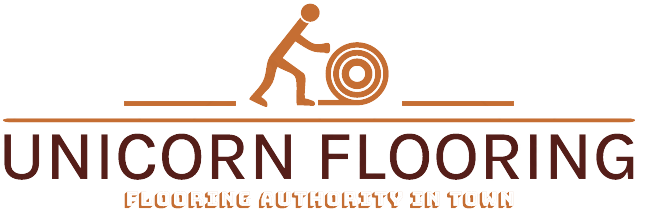Pharmaceutical flooring in Pakistan
Pharmaceutical manufacturing is unforgiving: even tiny dust particles, a hairline crack or the wrong cleaning chemical can threaten product quality, trigger regulatory action, or put patients at risk. Flooring is one of the most important — and often overlooked — elements in a pharma facility. The wrong floor breeds contamination, the right floor helps control it. This guide covers what manufacturers, contractors and quality teams in Pakistan need to know: local regulatory context, industry standards, suitable floor systems, design & installation best practices, validation & testing, maintenance, budget expectations, and a short FAQ at the end.
Why flooring matters in pharma?
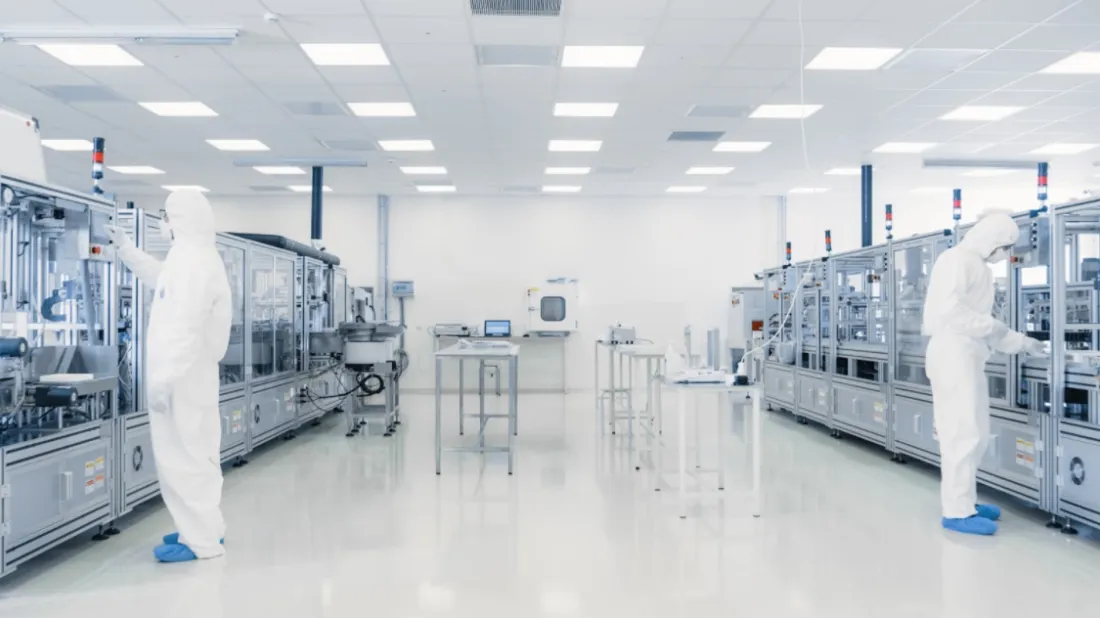
Floors are the primary reservoir and transport pathway for particles, dust, microbes and chemical residues. A floor that is:
- Seamless (no joints or grout lines),
- Non-shedding (doesn’t release particles),
- Chemical- and solvent-resistant,
- Easy to clean and disinfect, and
- Mechanically durable (handles trolleys, forklifts, spills)
…makes it much easier to meet cleanroom/GMP requirements and maintain product integrity. Conversely, porous, cracked, tiled or improperly detailed floors create hidden niches for contamination and increase cleaning time and validation failures. International cleanroom and GMP guidance repeatedly call out flooring design and materials as essential elements of contamination control.
Regulatory context in Pakistan
If you operate in Pakistan you must design and run your facility in line with DRAP (Drug Regulatory Authority of Pakistan) GMP expectations. DRAP’s GMP guidance (and draft GMP/QMS documents published on the DRAP site) provide the local regulatory baseline for pharmaceutical manufacturing sites—covering premises, sanitation, maintenance and validation requirements that directly affect flooring design and upkeep. In practice, DRAP expects firms to apply international GMP best practices (PIC/S, EU/FDA principles) adapted to local licensing and inspection.
It’s also worth noting that Pakistan’s regulator has signalled alignment with PIC/S and international GMP concepts; facilities seeking export markets or global audits should adopt PIC/S/EU Annex-1–compatible solutions where appropriate.
Standards & guidance to design to
When specifying floors for pharma areas you will repeatedly refer to:
- DRAP GMP — for local licensing/inspection expectations.
- WHO Good Practices / Annexes — for labs and quality control guidance and sterile products (cleanroom-related advice).
- ISO 14644 series — for cleanroom classification, airborne particle limits and implications for furnishing and finishes (including flooring). Flooring systems used in ISO-classified areas should be selected and installed to minimise particle generation and support the required classification.
- EU GMP Annex-1 / PIC/S — relevant to sterile product manufacture (if you produce sterile products, follow Annex-1 design and monitoring expectations).
Together these documents tell you what outcomes you must achieve (cleanliness, non-shedding, cleanability, chemical resistance, traceability and validation), but they don’t always prescribe a single product — that’s up to engineering, QA and procurement teams.
Common pharmaceutical flooring systems (pros & cons)
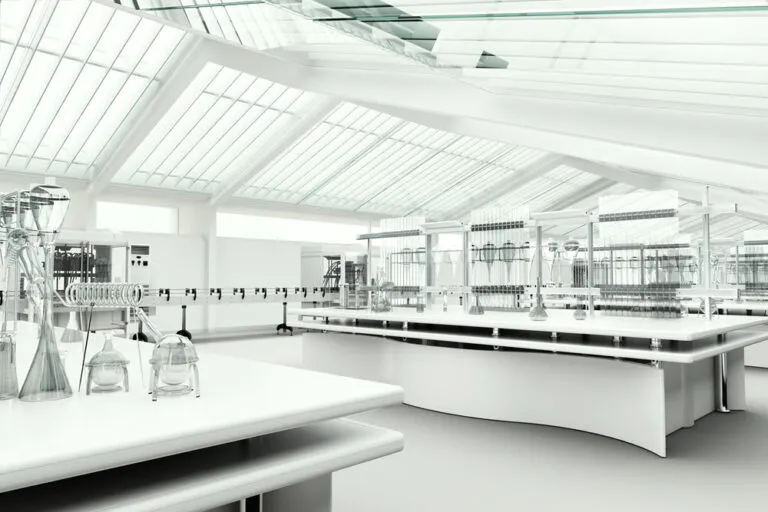
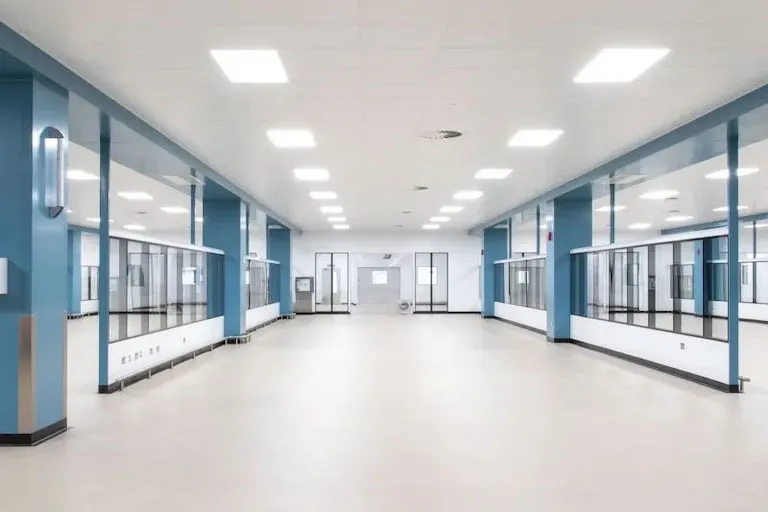
Below are the systems most commonly specified in pharma/cleanroom applications, with quick guidance on where each is appropriate:
1. Seamless epoxy resin flooring (multi-layer systems)
Pros: seamless, excellent chemical resistance, easy to clean, durable, available in anti-slip finishes, coved skirting possible.
Cons: some epoxy formulations can yellow with UV; not all epoxies tolerate aggressive sterilants or very high temperatures — choose pharmaceutical-grade systems.
Best for: production halls, packaging, QC labs, many non-sterile cleanrooms.
2. Urethane (polyurethane) and urethane-cement mortar floors
Pros: superior abrasion resistance, better thermal/chemical resistance than some epoxies, fast cure options, very durable.
Cons: higher cost than typical epoxy coatings; installation needs experienced crews.
Best for: heavy duty production, areas with regular heavy traffic or wheel loads, wet areas.
3. Heat-welded sheet vinyl (homogeneous vinyl)
Pros: non-shedding if heat-welded seams are used, proven in many ISO-5/ISO-7 cleanrooms, comfortable for long shifts, chemically tolerant options available.
Cons: requires high skill to weld seams; subfloor must be very well prepared; not ideal if mechanical impact resistance is critical.
Best for: sterile filling suites, labs, ISO-5 to ISO-7 cleanrooms where anti-static options are not required.
4. Electrostatic-dissipative (ESD) flooring systems
Pros: necessary in areas with sensitive electronic equipment or flammable solvents; prevents static discharge.
Cons: only needed in specific zones; conductivity must be validated and maintained.
Best for: equipment rooms, certain QC labs, packaging lines with electronic assemblies.
5. Methyl methacrylate (MMA) rapid-cure systems
Pros: fast cure (useful for short shutdown windows), decent chemical resistance.
Cons: strong odor during installation; temperature sensitivity during install; not always first choice for sterile suites.
Best for: quick turnarounds and retrofit projects where downtime cost is high.
6. Raised access flooring (with sealed top surface)
Pros: convenient for under-floor air handling, cable services and returns.
Cons: joints and panels can be contamination risks unless sealed and validated; more complex to clean.
Best for: certain HVAC/air-return strategies in larger cleanrooms — only with careful design and sealing.
(Choosing the right system is a function of cleanroom grade, chemical exposure, mechanical loads, downtime tolerance and budget. For sterile production, you’ll normally combine heat-welded vinyl or high-grade seamless resin systems with coving and validated cleaning regimes.)
Design details that make or break a floor
Even the best material fails if poorly detailed. Pay attention to:
- Seamless coving (coved skirting): 50–100 mm minimum radius coving cove eliminates joints between wall and floor and prevents fluid/niche traps.
- Slope and drains: wet processing areas must have controlled falls towards easily cleanable drains; avoid open gullies.
- Joints & transitions: expansion joints in slabs must be properly treated with resin fillers or bonded profiles; avoid exposed grout lines.
- Surface texture: slick high-gloss finishes look clean but may be slippery when wet; specify subtle slip resistance where needed (fine aggregate or non-slip topcoat).
- Wall-to-floor seals: all penetrations and service entries must be sealed with pharma-grade sealants resistant to disinfectants.
- Service penetrations: detail to be flush and sealable; avoid equipment feet that create recesses.
- ESD continuity: for ESD floors ensure continuous conductive paths to earth and regular verification.
- Fume and chemical exposure: select systems rated for the specific sterilants and solvents used (e.g., peracetic acid, IPA, chlorinated alkalis).
Getting these details right reduces cleaning time, supports validation, and avoids recurrent repairs.
Installation best practices (short checklist)
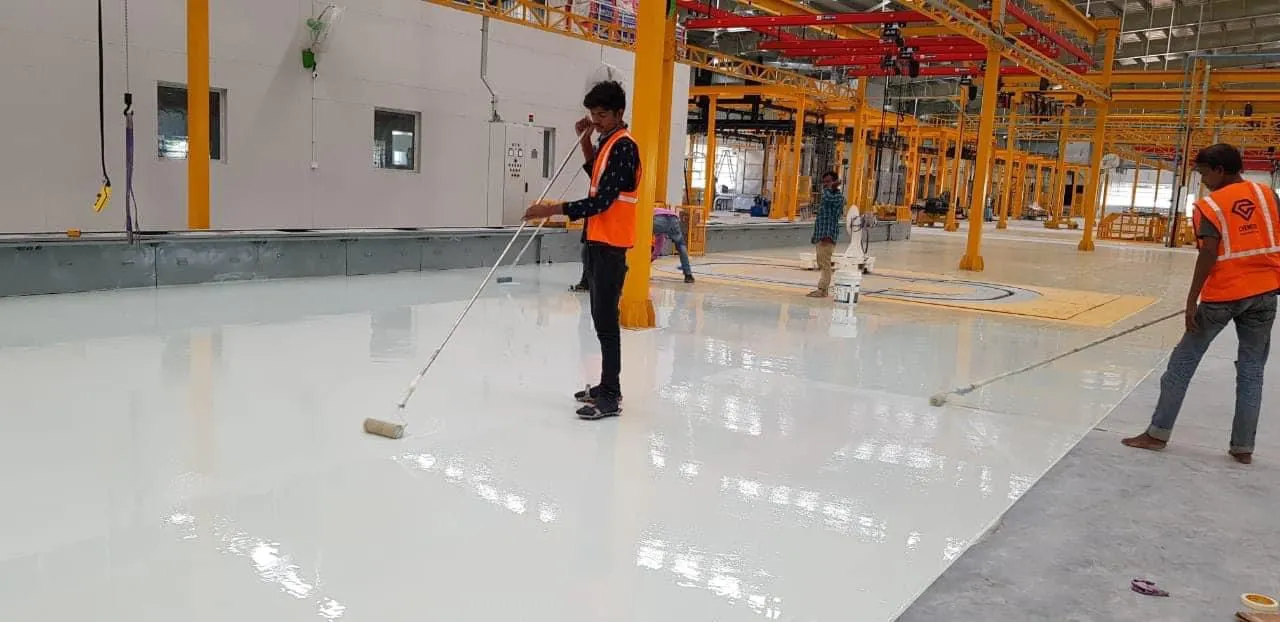
- Start with substrate preparation: remove laitance, level to tolerance, repair cracks, treat movement joints. Moisture mitigation is critical — measure and, if necessary, use moisture-tolerant primers or membranes.
- Qualified applicators only: pharma floors demand experienced crews who follow manufacturer mixing/temperature/humidity windows.
- Mock area: for critical rooms, install a small mock-up area to verify finish, coving, and cleaning protocols before full rollout.
- Controlled conditions: maintain recommended ambient temperature/humidity during cure to avoid coating failures.
- Curing & protection: allow full cure per system before traffic; schedule equipment movement to avoid indentations or scuffs.
- Acceptance testing: perform adhesion pull-offs, thickness checks, and visual inspection with QA signoff before commissioning.
Failures almost always trace back to poor substrate prep, high moisture, or rushed curing.
Validation & testing (IQ / OQ / PQ and routine monitoring)
Floor acceptance is part of facility qualification:
- IQ (Installation Qualification): confirm installed system matches specification (system components, batch numbers, thickness, coving, seam details).
- OQ (Operational Qualification): functional tests — adhesion, slip testing, ESD measurement (if required), chemical resistance spot tests, and surface particle shedding tests if requested.
- PQ (Performance Qualification): verify floor performs in operational use — cleaning cycles, resistance to disinfectants, and maintained particle/bioburden metrics over time.
Routine monitoring should include periodic visual inspections, adhesion checks (after major events), ESD continuity testing, and trend records of cleaning efficacy and any repairs. Maintain a validation dossier linking product batches, install records and QA test results for DRAP inspections and audits. (These validation steps align with GMP expectations used locally and internationally.)
Cleaning & maintenance — keeping it compliant
A well-written cleaning protocol is as important as the floor product:
- Approved chemicals: list compatible disinfectants (and concentrations) tested on a spare floor sample. Some solvent-based sterilants can attack weaker resins.
- Frequency & method: define daily sweeping/mopping, periodic deep cleaning and disinfectant contact times. Use low-shedding microfibre mops and dedicated cleaning tools per area.
- Avoid harsh mechanical scrubbing unless required — abrasive pads can damage the topcoat and create micro-nooks.
- Repair plan: minor damage should be repaired with approved touch-up kits and recorded in maintenance logs; major damage may require full re-coat.
- Record keeping: cleaning logs, chemical batch labels, and maintenance activities must be traceable for GMP audits.
- Training: cleaning teams must be trained, their SOPs documented and observed during audits.
Good maintenance extends service life and keeps validation intact.
Common problems and how to avoid them

- Bubbling/Blistering: often due to moisture vapor drive or trapped air during cure — test moisture and allow proper prep.
- Peeling/Delamination: poor substrate prep or insufficient primer — remedy via pull-off testing and re-installation of problematic areas.
- Yellowing/Softening: some epoxies degrade with certain disinfectants or UV exposure — specify systems rated for the chemicals you use.
- Cracking at movement joints: improper treatment of expansion joints — use flexible joint profiles or design joints out of critical clean zones.
- High particulate counts: wrong surface finish (shedding), poor coving detail or dirty cleaning equipment — assess and change materials or cleaning SOPs.
Most issues are preventable with correct material selection and attention to substrate prep.
Budget & lifecycle expectations (very approximate)
Costs in Pakistan depend on system, area preparation and project logistics. Rough rule-of-thumb ranges (USD/kg or per m² vary by supplier, currencies and project complexity):
- Basic epoxy coating (thin): lower capital cost, suitable for non-critical areas — cheapest option.
- Full trowelled urethane cement / heavy duty systems: higher upfront cost but long life under heavy traffic.
- Heat-welded vinyl: moderate to high cost depending on quality and welding.
- MMA fast cure: premium for rapid turnaround.
Consider total cost of ownership: downtime, maintenance intervals, chemical resistance and repair frequency. A slightly higher initial investment in a higher-grade system often pays back through lower maintenance and fewer validation headaches.
(For accurate current pricing contact local suppliers and ask for a detailed BOQ and warranty/maintenance package.)
Choosing a contractor in Pakistan — checklist
- Experience with pharmaceutical projects (ask for references and site visits).
- Demonstrated GMP installations and willingness to supply IQ/OQ/PQ documentation.
- Established aftercare and warranty terms and a maintenance training program.
- Use of pharma-grade materials with technical data sheets and MSDS in English/Urdu.
- Ability to perform substrate moisture testing and show pre-install reports.
- Capacity to coordinate shutdowns and manage odour/venting during installation.
Insist on a written quality plan and test schedule before awarding the job.
Conclusion
Flooring is a strategic decision for any pharmaceutical facility in Pakistan. It affects contamination control, regulatory compliance, cleaning labour, and operating costs. Follow DRAP GMP, reference international cleanroom standards (ISO 14644, WHO, EU Annex-1 where applicable), and choose materials and contractors based on measurable performance — not only on price. Invest in proper substrate prep, validated installation, and a documented cleaning/maintenance regime: that’s where you convert an expensive capital project into a long-term competitive advantage.
Seamless epoxy or polyurethane resin systems and heat-welded sheet vinyl are most common — selection depends on room grade, chemical exposure and mechanical loads.
Yes. Coved skirting (sealed, seamless) is standard practice to eliminate crevices and simplify cleaning in GMP areas
Via IQ/OQ/PQ: installation records, adhesion/thickness tests, chemical resistance checks and operational monitoring to confirm performance under production conditions
Lifecycle varies by system and use — well-specified urethane mortar or high-grade epoxy can last 7–15+ years with proper maintenance; cheaper systems will need earlier touch-ups. (Actual life depends on traffic, chemicals and maintenance.)
Only small patch or localized works can be done in situ. For full installations you typically schedule controlled shutdowns; MMA systems offer faster cure for short turnarounds but require strict venting & safety controls.
DRAP enforces GMP for pharmaceutical manufacturing sites; during inspections the facility must demonstrate compliance via documentation and validation evidence
